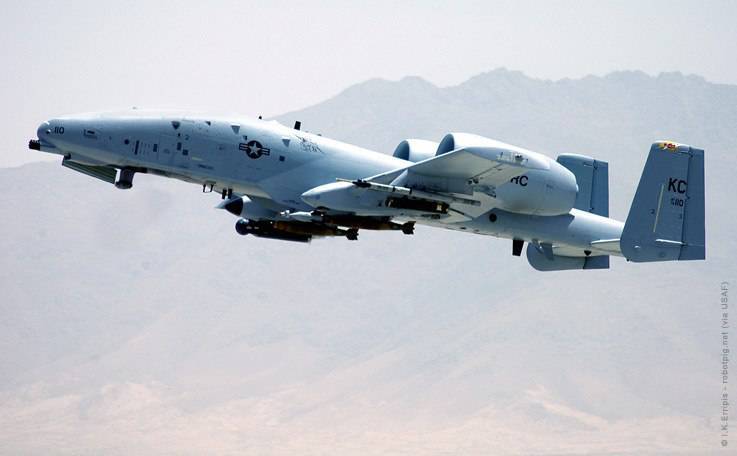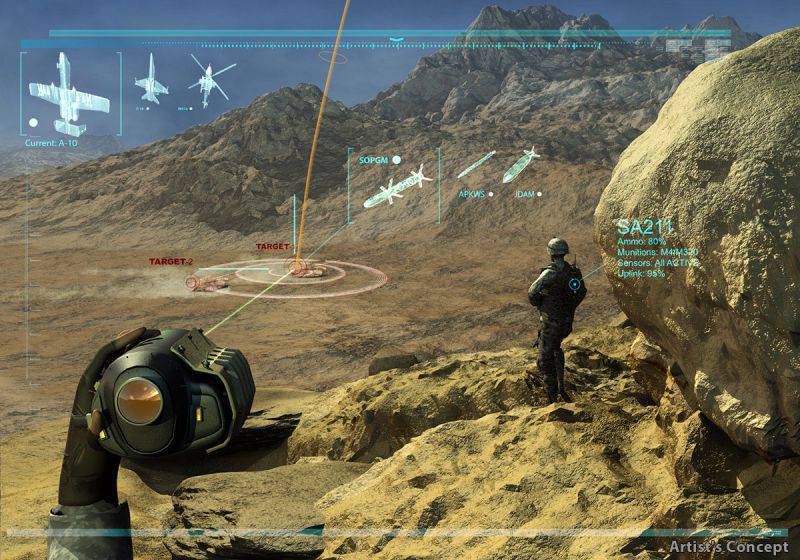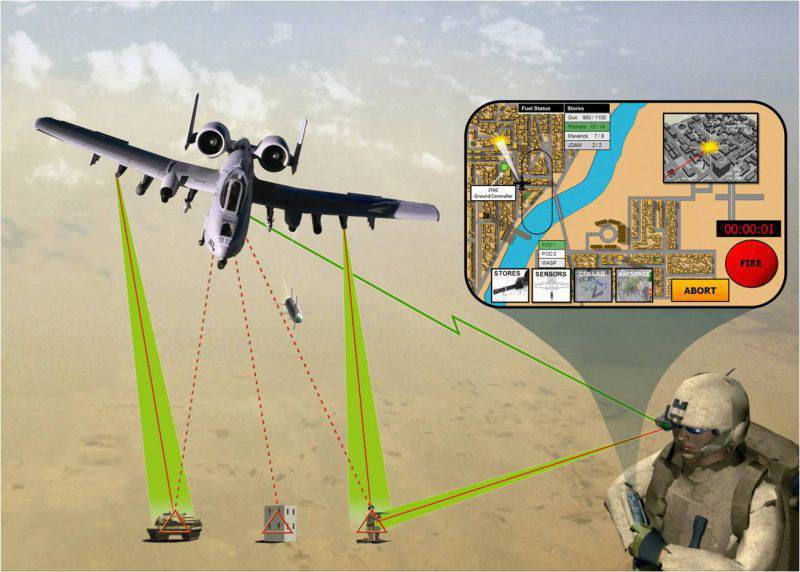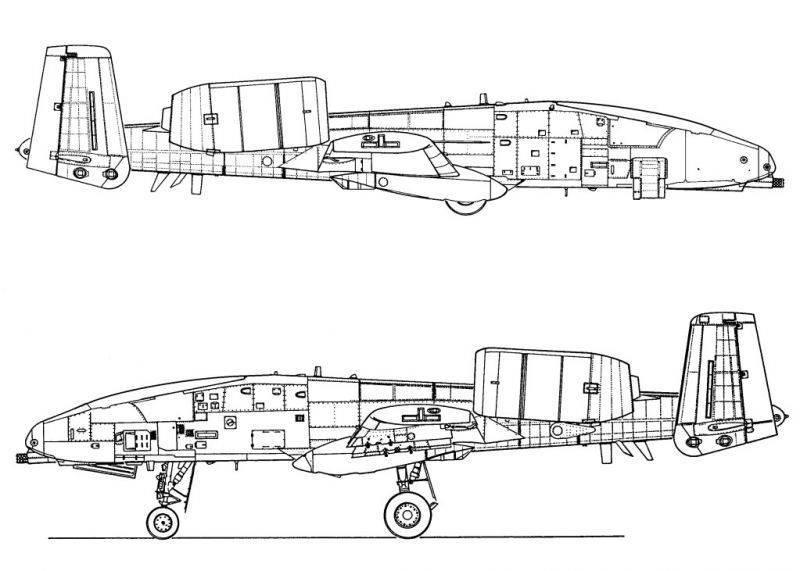Perspective communication and control system PCAS (USA)
In order to provide the troops with the necessary capabilities, a PCAS program (Persistent Close Air Support - “Permanent direct aviation support”) was launched several years ago, within which various samples of equipment and equipment were developed. The essence of the proposed system is the use of a number of ground-based components and special equipment, including spacecraft, as well as equipment, which is part of the equipment of army units and a set of on-board electronics for tactical aircraft. The implication was that with the help of their equipment, the fighters would be able to indicate the location of enemy troops or objects, which would be transferred to aviation. According to the first calculations, such an approach to the call of air support provided by modern equipment would reduce the aviation response time several times.
Several years ago, some features of the PCAS system became known, in particular, the composition of the equipment that is planned to be issued to the units. According to some reports, the ground forces and aviation units should receive a set of equipment, including tablet computers with an operating system built on the basis of the Android platform. Such equipment, as expected, will help the troops to cause support with just a couple of taps on the touch screen. After selecting a target and requesting an attack, the automatics must independently process the information and transmit it to the tactical aviation employed in the system of direct support to the ground units.
The most interesting element of the air support system could be the upgraded Fairchild Republic A-10 Thunderbolt II attack aircraft. As part of the PCAS program, it was planned to develop a draft revision of this aircraft aimed at improving its combat qualities. In addition to the use of new elements of on-board equipment for the transmission of data on targets, A-10 could receive remote control systems.
In the summer of 2010, the agency DARPA, which oversees promising projects for the US armed forces, published the first information regarding the modernization of existing and the creation of promising air support aircraft. DARPA specialists have issued a request for information on advanced technology for PCAS system that meets the requirements. The request provided some thoughts on the current state of affairs in this area and the desired result.
DARPA experts noted that in the current situation, the implementation of direct support for troops is associated with a number of specific problems. The main difficulties are related to the communication systems used. Since voice radio is used to transmit data about the targets that need to be destroyed, various errors can occur. In addition, this method of communication and targeting is not conducive to reducing the reaction time. Depending on the circumstances of the situation, from data transfer to impact, it can take up to 30-60 minutes.
There are also problems inherent in manned aircraft. Airplanes or helicopters of direct support have limitations on patrol time, flight range, etc. In addition, the person in the cockpit is not immune from mistakes, which adds problems to an already difficult situation.
After analyzing the situation, the experts of the DARPA agency came to the conclusion that it was necessary to create new attack aircraft with several specific features. Program participants were required to work on the look of the upgraded A-10 attack aircraft, which can fully function within the PCAS system. A separate requirement related to control systems. It was planned to work out both the modernization of the manned A-10 aircraft and to determine the possibility of developing an unmanned version of this attack aircraft. In the future, it was planned to build / retool prototypes of a promising attack aircraft and conduct its tests.
Quite quickly, the military abandoned the idea of using an unmanned version of the A-10 or a modification with the possibility of remote control while maintaining the cockpit. Calculations have shown that such options turn out to be too complicated to implement in comparison with the relatively simple modernization of existing equipment by installing a set of communication and target designation equipment. Approximately by 2011-12, all studies on the subject drone based on the A-10 aircraft were discontinued.
Based on the analysis of the proposed projects, DARPA chose the lead contractor, who was to develop all the elements of the PCAS system. They became the company Raytheon, which is one of the main developers of electronic systems for the US armed forces. By the end of 2012, the development of individual elements of the PCAS system was completed, after which their tests began. At the end of 2012 and the beginning of 2013, DARPA, together with Raytheon, produced and transferred a number of elements of the system to the grouping of US troops operating in Afghanistan. The 500 order of tablet computers was used by the army to monitor the situation and to target aircraft and support helicopters. Tests have shown that such equipment can reduce the time required to complete the strike to 6-10 minutes.
In February 2014, Raytheon received an order for the next phase of the project. In the course of this work, specialists had to create a set of special equipment intended for installation on existing A-10 attack aircraft. Over the next 18 months, the contractor had to do all the work, including testing the modified aircraft. The cost of this contract was 25 million dollars.
Last fall, the retrofit of the experienced A-10, designed to participate in the trials, was completed. In October, the first flight of the prototype took place, during which the operation of various systems was tested. Over the next two months, communications facilities and target data systems were tested. In December, the beginning of the next stage of tests with the use of weapons was planned. Last year, it was argued that all tests could be completed by the end of the spring of 2015. In the future, it will be possible to establish mass production of equipment and its delivery to the troops.
The full implementation of the PCAS communications and targeting system will take several years to complete. As an experienced strike aircraft designed to support the troops, the modified A-10 attack aircraft are currently used. In the future, for these purposes can be used and other aircraft or helicopters that can carry the necessary set of weapons. It is planned to use guided bombs and missiles, as well as airborne cannons for attacking the targets indicated by ground forces.
In recent years, US Air Force tactical aviation has undergone some noticeable changes. Several years ago, the launch of A-10 ground attack aircraft began in reserve. By the end of the next decade, these planes are planned to be written off and gradually replaced by newer technology. As a replacement for these attack aircraft are considered the latest multi-purpose fighters Lockheed Martin F-35 Llightning II. Obviously, in the event of further construction and development of the PCAS system, new aircraft will receive the appropriate equipment, which will be used to obtain targeting before striking enemy targets.
Back in 2010, when the option of creating an attack drone on the basis of the A-10 attack plane was considered, several photo collages appeared in foreign publications depicting the possible appearance of this machine. Despite the absence of any official information about such equipment, experts and military enthusiasts began to discuss the possibility of creating an unmanned version of the A-10. After News on the refusal to develop a strike UAV or a machine with the possibility of operation in a manned and unmanned version, discussions on this issue ceased. However, collages depicting the unmanned A-10 “pop up” from time to time and become a cause for new debate.
With the light hand of the author of one of the collages, a hypothetical unmanned attack aircraft project received the designation QA-10, compiled in accordance with the rules of the nomenclature of the United States Air Force. The published collage depicted an A-10 aircraft with a “modified” fuselage. The author of the image has removed the cockpit lantern, instead of which the fairing of the corresponding shape was drawn. Thus, instead of the cockpit on a hypothetical drone there was a smooth trim with some kind of control equipment under it.
Other structural elements of the drawn aircraft remained the same: the fuselage has a characteristic curved shape with two nacelles above the tail boom, a low-lying straight wing and a stabilizer with spaced keels. The drone conceived by the artist had to carry the GAU-8 / A Avenger automatic cannon and a number of guided missiles and bombs. Under the wing of the base attack aircraft there are 8 pylons for the suspension of weapons. More 3 suspension points are provided under the fuselage. Thus, the unmanned version of the attack aircraft should have been able to preserve such possibilities of carrying a combat load.
Despite all the expectations of the public, the project to develop an unmanned attack aircraft QA-10 or A-10PCAS, as it was called in some publications, was not developed. According to the results of preliminary studies, it was decided that the creation of such equipment is associated with a number of serious problems, the solution of which at the current level of technology development will be too complicated and will not justify the costs. In particular, difficulties should have arisen with the development of a control system “sharpened” for combat work at low altitudes, typical of the usual practice of using manned A-10 attack aircraft. As a result, it was decided to abandon plans to build an unmanned attack aircraft based on the existing technology.

Nevertheless, the PCAS system can later be used to control the combat work of the drone drone aircraft. Shortly after abandoning the development of UAVs based on A-10, it was decided to adjust the requirements for the prospective heavy reconnaissance-impact drone, which will be developed and used in the future. According to some data, the inclusion of PCAS equipment in the equipment of existing unmanned aircraft complexes is not precluded now. Such a step will reduce the response time of strike aircraft when supporting the troops without the need to build a new aircraft or major modernization of the existing one.
In the near future, it is planned to begin the deployment of the PCAS system, which will help simplify and accelerate the implementation of direct air support in a combat situation. The ground units are planned to be equipped with special tablet computers with the possibility of target designation and data transmission of tactical aviation. Some aircraft, in turn, must receive appropriate receiving equipment. In case of successful completion of the work, several types of aircraft available from the Air Force will receive equipment. In addition, in the future it will be equipped with new aircraft, including unmanned aerial vehicles. At the moment, it cannot be ruled out that as part of the construction of the PCAS system, it will be decided to put the A-10 attack planes in the reserve back into service. It is on the basis of such aircraft that a new system is being tested, and in the future they may become one of its main shock weapons.
It should be noted that if the Pentagon decides to return to the A-10 attack aircraft, then it will be the existing manned aircraft with a set of new equipment that will be operated. The likelihood of developing a UAV project like the one drawn by QA-10 is extremely small. If it is decided to use drone drones as part of the PCAS system, then it will probably be existing or new cars of this class, and not converted aircraft. Anyway, over the next few years, the US military will receive a new, more advanced communications system and tactical level control.
On the materials of the sites:
http://darpa.mil/
https://fbo.gov/
http://defensetech.org/
http://robotpig.net/
http://globalsecurity.org/
http://diydrones.com/
http://warbirdinformationexchange.org/
http://strangernn.livejournal.com/
http://secretprojects.co.uk/



Information